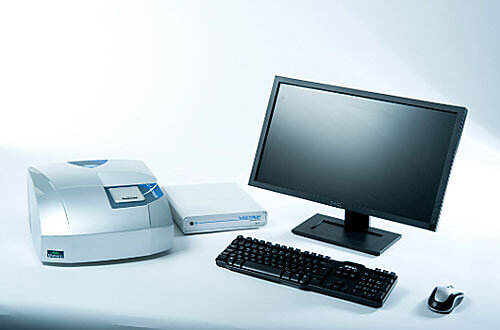This application note describes a selection of measurements made on a GE AKTA basic system. Since the unit only contains a UV detector for measuring sample concentration, this can be used for the molecular weight calculations instead of the more commonly used refractive index detector, provided that the molar extinction coefficient of the sample protein is known. If this is not known, then reliable estimates can be made based on the amino acid sequence of the sample.
The Zetasizer μV is a dynamic and static light scattering (DLS & SLS) system capable of making measurements of molecular size and molecular weight in a batch cuvette and also when connected to a size-exclusion chromatography (SEC) system in conjunction with an OmniFACE connection box (figure 1).

The Zetasizer μV has a 90° detection angle with excellent signal-to-noise and a variable power laser and attenuator to help it to achieve a wide dynamic range with respect to the light scattering count rate. Additionally, the light scattering volume, which is the intersection of the illuminating laser and detector field, is very small. This allows very small volumes of sample to be measured. In a batch cuvette, measurements can be made in as little as 2 μl while the flow cell used with the system is just 8 μl. Switching between batch and chromatography modes takes only seconds for the removal of the batch cuvette and insertion of the flow cuvette or vice versa.
The application arena for the Zetasizer μV is primarily the characterization of proteins and the design is such that it can be interfaced with almost any third-party SEC system such as the commonly used GE AKTA. This application note describes a selection of measurements made on a GE AKTA basic system. Since the unit only contains a UV detector for measuring sample concentration, this can be used for the molecular weight calculations instead of the more commonly used refractive index detector, provided that the molar extinction coefficient of the sample protein is known. If this is not known, then reliable estimates can be made based on the amino acid sequence of the sample.
Download the full Application Note as PDF
Malvern provides the materials and biophysical characterization technology and expertise that enables scientists and engineers to investigate, understand and control the properties of dispersed systems. These systems range from proteins and polymers in solution, particle and nanoparticle suspensions and emulsions, through to sprays and aerosols, industrial bulk powders and high concentration slurries. Used at all stages of research, development and manufacturing, Malvern’s instruments provide critical information that helps accelerate research and product development, enhance and maintain product quality and optimize process efficiency. Our products reflect Malvern’s drive to exploit the latest technological innovations. They are used by both industry and academia, in sectors ranging from pharmaceuticals and biopharmaceuticals to bulk chemicals, cement, plastics and polymers, energy and the environment. Malvern systems are used to measure particle size, particle shape, zeta potential, protein charge, molecular weight, mass, size and conformation, rheological properties and for chemical identification, advancing the understanding of dispersed systems across many different industries and applications. www.malvern.com Material relationships http://www.malvern.com/en/ portal@malvern.com






